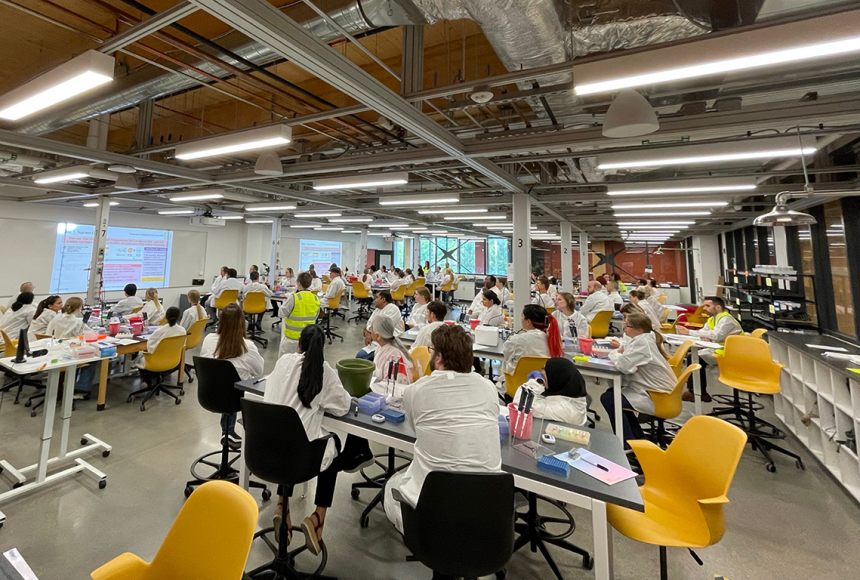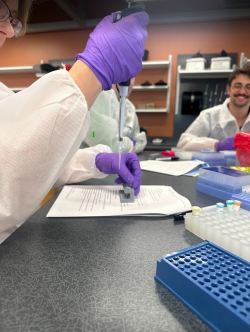
Over the course of three days, nearly 100 attendees from 49 veterinary diagnostic laboratories across 41 states in the United States Department of Agriculture’s National Animal Health Laboratory Network (NAHLN) gathered at Michigan State University’s STEM Teaching and Learning Facility for the first half of the NAHLN Next-Generation Sequencing Symposia. Next-generation sequencing, or NGS, involves capturing the genetic code of an organism to learn about the organism’s characteristics and behaviors.
In the case of cancer, this technology can help guide therapeutic strategies and inform prognosis. In the case of infectious disease, it can shed light on pathogen evolution, host specificity and host range. For example, with the ongoing outbreak of highly pathogenic avian influenza, sequencing can help scientists monitor how the virus is changing and adapting over time to give clear insights into where priorities should lie in terms of disease mitigation and public health protection strategies.
Sequencing is also an incredibly helpful tool for identifying pathogens causing illness. Traditional diagnostics require that a pathogen is suspected based on clinical signs and history. Individual tests would be run looking for that specific pathogen. In other words, if you don’t know what you’re looking for, it’s hard to find it using traditional assays. With sequencing, one sample can be analyzed to identify any pathogens present, even if they aren’t initially suspected. This approach can also help to detect an unknown or novel pathogen sooner.
“Essentially, for a very long time, our diagnostic tools have let us read the CliffsNotes version of what’s happening and now we’re getting to read the whole book with sequencing,” explains Kayla Conner-Halim, NAHLN regional scientist at the MSU Veterinary Diagnostic Laboratory.
Conner-Halim serves on the symposia planning committee and managed the logistics for the MSU-hosted component. The planning committee is composed of laboratory professionals from two other NAHLN laboratories, Colorado State University Veterinary Diagnostic Laboratories and the California Animal Health and Food Safety Laboratory System.
The motivation for the symposia is to create an environment where attendees can learn new skills, create connections for better communication and information transfer, and create standard processes that can be used across laboratories.

“On the technical side, the techniques needed to generate and analyze this data are very specialized and, in many cases, new and still under development,” says Conner-Halim.
“That’s where the standardization comes in. We have to decide what’s important and what’s not so important or else we could get really lost in the weeds right now. There’s also not as much education available for this type of specialized approach compared to other techniques.”

The symposia are organized around measurable outcomes and participants will be able to apply what they learn when they return to their home laboratories.
“We had participants from as far away as Hawaii—these attendees are dedicated to learning this, and they took time away from their jobs to be here. These are the people who actually do the work, so they’re going to go home and go back to work and have all of this new knowledge. During the presentations, I haven’t seen a single person on a cell phone. People have really honored staying in the moment,” says Conner-Halim.
The portion of the symposium hosted at MSU focused on basic technical and bench skills, troubleshooting, and generating data. In the second half of the symposia hosted at Colorado State University in July, attendees will learn how to analyze the data generated by NGS.
The MSU Veterinary Diagnostic Laboratory, a service unit in the MSU College of Veterinary Medicine, is a premier, full-service, fully accredited veterinary diagnostic laboratory. On average, the Laboratory performs over one million tests per year for more than 300,000 animals. The MSU VDL is a member of the NAHLN and other key federal networks charged with protecting animal and public health, and their core diagnostics, expert service, and innovative solutions have earned them over 10,000 clients in all 50 states and more than 25 foreign countries.
